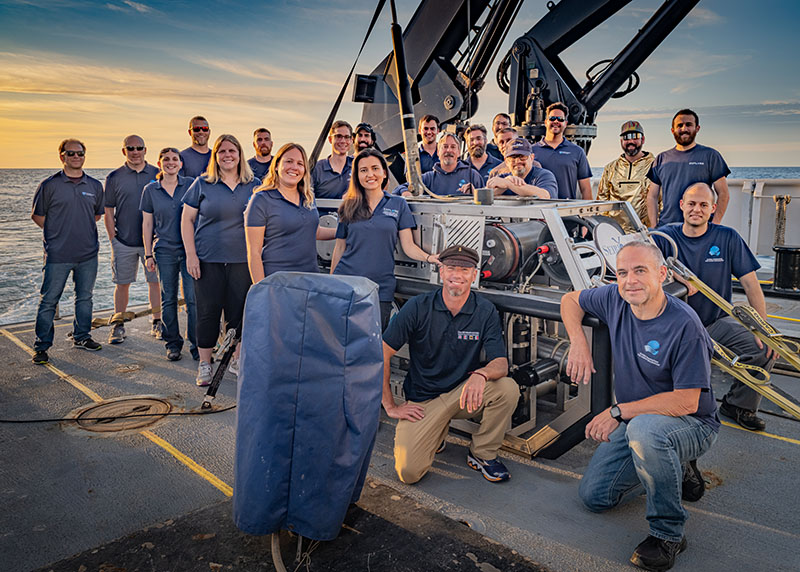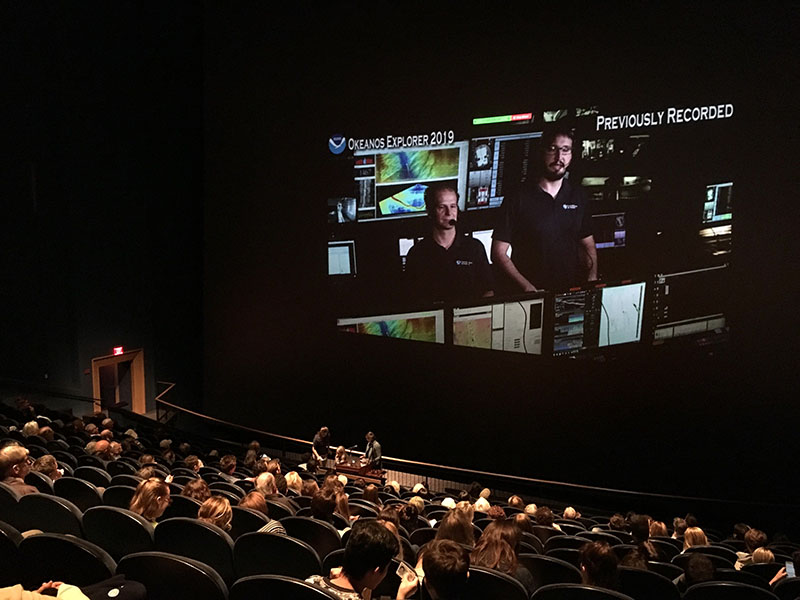
Date: September 15, 2019
Location: Lat: 41.61270°, Lon: -71.40724°

The mission team onboard NOAA Ship Okeanos Explorer for the Deep Connections 2019: Exploring Atlantic Canyons and Seamounts of the United States and Canada expedition. Image courtesy of Art Howard, Global Foundation for Ocean Exploration, Deep Connections 2019. Download larger version (jpg, 47.2 MB).
NOAA Ship Okeanos Explorer pulled into port in North Kingston, Rhode Island this morning, bringing to an end the Deep Connections 2019 expedition. Despite a number of delays due to mechanical and weather-related issues, including Hurricane Dorian, the team was able to conduct twelve remotely operated vehicle (ROV) dives, including one midwater dive, in deep waters off the U.S. and Canadian Atlantic Continental Margin. Six of these dives took place in deep extensions of marine managed areas, including the Gully Marine Protected Area, the Northeastern Canyons and Seamounts Marine National Monument, and the Frank R. Lautenberg Deep Sea Coral Protection Area. Deep-sea corals and sponges were recorded on all of the eleven benthic-focused dives of the expedition, and high-density communities of deep-sea corals and sponges were documented during five of the dives.
Another primary objective of the expedition was mapping, particularly in areas were no such data exists. The expedition mapped deep-sea areas around the Northeast Channel, the Fundian Valley, North of Alvin Canyon, and along the U.S.-Canadian boundary, which had never before been mapped using high-resolution sonars. We also hosted five live interactions during this expedition, including events with Congressional staff members, and with visitors to the Mystic and New England Aquariums. With our Canadian partners, we were able to launch a new exploration command center at the Bedford Institute of Oceanography in Dartmouth, Nova Scotia, which allowed for transnational collaboration, learning, and exchange in real time during the mission. A total of 51 scientists from seven different countries and 13 U.S. states participated in the expedition remotely via telepresence technology as part of the shore-based science team. Finally, with over 112,000 views of our live streamed video feed during the expedition, we were thrilled to have so many members of the public join us as we explored.

The live interaction with the New England Aquarium on September 12, 2019, featured Science Lead Jeff Obelcz and Expedition Coordinator Daniel Wagner, and drew a crowd of 164 audience members. Image courtesy of the New England Aquarium. Download larger version (jpg, 3.4 MB).
Mission personnel spent the day working on end-of-cruise reporting, while others began to mobilize for our next expedition, a mapping mission that will take place between October 5th-26th, in deepwater habitats of the Southeastern U.S. Continental Margin. Shortly after this, our next live-streamed ROV mission will begin on October 31st. We hope you will join us again then!

The location of the Okeanos Explorer on September 15, 2019, on the last day of the Deep Connections 2019 expedition. Image courtesy of the NOAA Office of Ocean Exploration and Research, Deep Connections 2019. Download larger version (jpg, 1.8 MB).